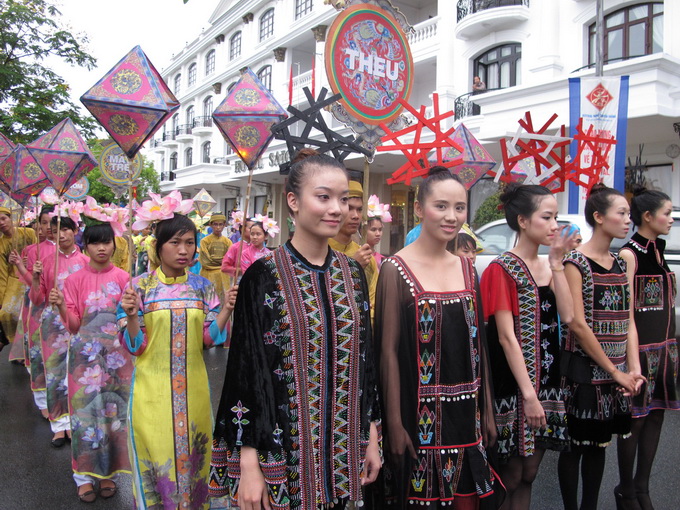Collections of visually-striking, colorful Vietnamese tho cam (brocade) from different regions and demonstrations of how artisans produce it have enthralled spectators during the five-day 2013 Hue Traditional Craft Festival, which ended yesterday in Hue.
The tho cam items, which come in a wide variety of shapes, colors and purposes, are made by Mong ethnic minority people from northern Ha Giang province, by Ta Oi minority people in central Thua Thien – Hue province, and by Cham people from Ninh Thuan province.
The northern brocade
At the section displaying the tho cam produced by Mong people inhabiting the northern mountainous region, the artisans in colorful brocade clothes are seen weaving over their traditional looms.
The painting of wax on the fabric before dying it is the key to the beauty of the region’s tho cam. The cloth areas with the wax won’t absorb dye, creating unique patterns.
These are only a few of the 41 phases involved in the making of tho cam by the Mong people.
“Our tho cam is all made from lanh (flax). Our art dates back thousands years. For us, wearing lanh is just like staying in an air-conditioned room, it keeps us warm in winter and cool in summer and even absorbs our perspiration while we’re toiling hard,” artisan Vang Thi Mai proudly said.
The central region’s brocade
A much-awaited highlight of the International Textile Fest, which was part of the 2013 Hue Traditional Crafts Festival, was a fashion show by famed designers which featured designs based on Asian and European traditions and raw materials.
Zeng, the brocade made by Ta Oi ethnic minority people in central Thua Thien-Hue province, inspired Minh Hanh, a gifted Vietnamese designer, to come up with a design using this special material.
“This is a unique product which is congruent with the world’s modern fashion trends,” Hanh quoted French textile experts as commenting on zeng.
Though Ta Oi people live near the Vietnam-Laos border, their zeng is quite distinct from the tho cam made in other regions.
The geometric patterns, which are depicted in only black, red, white and green, are simple reproductions of objects such as mountains, vegetation and animals in the forests nearby.
The allure of zeng lies mostly in the technique of attaching glass beads to the cloth during the weaving process, which is completely unique, making zeng stand out from other kinds of cloth by other ethnic minorities.
Apart from the horizontal bamboo poles, the artisans’ limbs and the curve of their backs are also indispensable parts of the looms, which are incredibly simple and portable.
“Zeng, which is known for its simplicity and rawness, meets the modern world’s simplifying fashion trends,” Hanh remarked.
The Cham people’s brocade
What draws the most attention from visitors about the tho cam produced by the Cham people from Ninh Thuan province are the two looms in one set which are distinctly different in their sizes, structures and weaving methods. The artisans at the high loom with coral pieces hung over it resemble artists playing musical instruments.
The brocades and demonstrations of the brocade making process appealed to local and foreign tourists alike.
“I’ve heard quite a lot about Vietnamese tho cam, but it’s the first time I’ve watched the distinct making processes of artisans from the three regions in Vietnam. I think the making of brocades will go much further and appeal even more if better promoted,” said Torsten Schawarz, a German tourist.
“In today’s modern world, Vietnamese brocades deserve to be celebrated as a national treasure,” Hanh noted.


















































